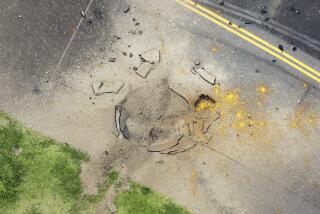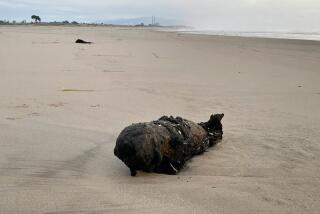AF Dropped H-Bomb in 1957 Accident
- Share via
ALBUQUERQUE, N.M. — A 42,000-pound hydrogen bomb accidentally fell from an Air Force plane 29 years ago, it was disclosed Wednesday, but officials said there never was any chance of a nuclear explosion.
No one was injured when the bomb hit an uninhabited area 4 1/2 miles south of Kirtland Air Force Base’s control tower on May 22, 1957, the Albuquerque Journal reported.
Minor Radioactivity
The bomb created a crater about 12 feet deep and 25 feet in diameter, and minor radioactive contamination was detected there, government documents obtained by the Journal said.
Non-nuclear explosives in the Mark 17 bomb detonated when it hit the ground, the documents said. But non-nuclear explosives must be triggered in a precise manner to cause a nuclear explosion, said Rich Garcia, spokesman for the Air Force Weapons Laboratory in Albuquerque.
“When a bomb accidentally falls, the impact of the fall triggers some (non-nuclear) explosives to go off, but not in the correct fashion,” he said Wednesday.
Dave Jackson, spokesman for the U.S. Department of Energy in Albuquerque, said there was another reason that it was physically impossible for the Mark 17 to produce a nuclear explosion in an accidental fall.
Portion Removed
The bomb “had a portion of the actual weapon removed and put in a different location,” he said. “It was routine procedure at the time.”
The Mark 17 fell 1,700 feet from an Air Force B-36 bomber as it was flying to Kirtland Air Force Base from Biggs Army Air Field in Texas, the documents said. Kirtland is situated just south of Albuquerque.
The government first reported the accident in 1981 in a brief release saying only that a nuclear weapon of some kind had been dropped. The documents obtained by the Journal through the Freedom of Information Act contain the first public description of the type of weapon involved and other details of the accident.
An exact reason why the bomb fell from the airplane, taking the bomb bay doors with it, was not given. But the government documents indicate a safety release mechanism apparently had been moved to the wrong position.
Explosive Yield Unknown
The government documents did not show the exact explosive yield of the bomb. But Stan Norris, a research associate with the Natural Resources Defense Council and a specialist on nuclear weapons, said most researchers believe it was more than 10 megatons.
“It is possibly the most powerful bomb we ever made,” Norris told the Journal.
Norris said the largest nuclear weapon in the U.S. arsenal today has a yield of about 9 megatons. A megaton measures the explosive yield of a nuclear weapon. It is the equivalent of 1 million tons, or 1,000 kilotons, of TNT.
More to Read
Sign up for Essential California
The most important California stories and recommendations in your inbox every morning.
You may occasionally receive promotional content from the Los Angeles Times.













